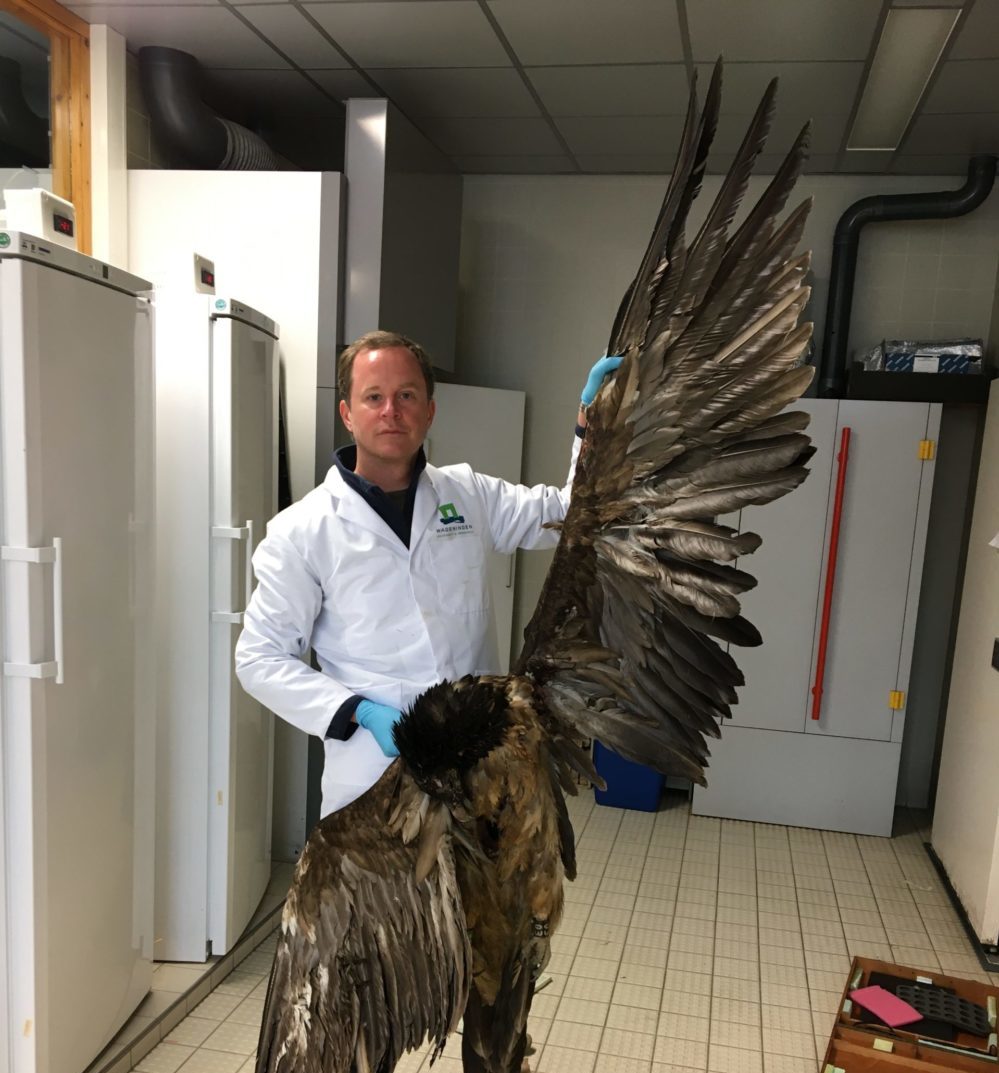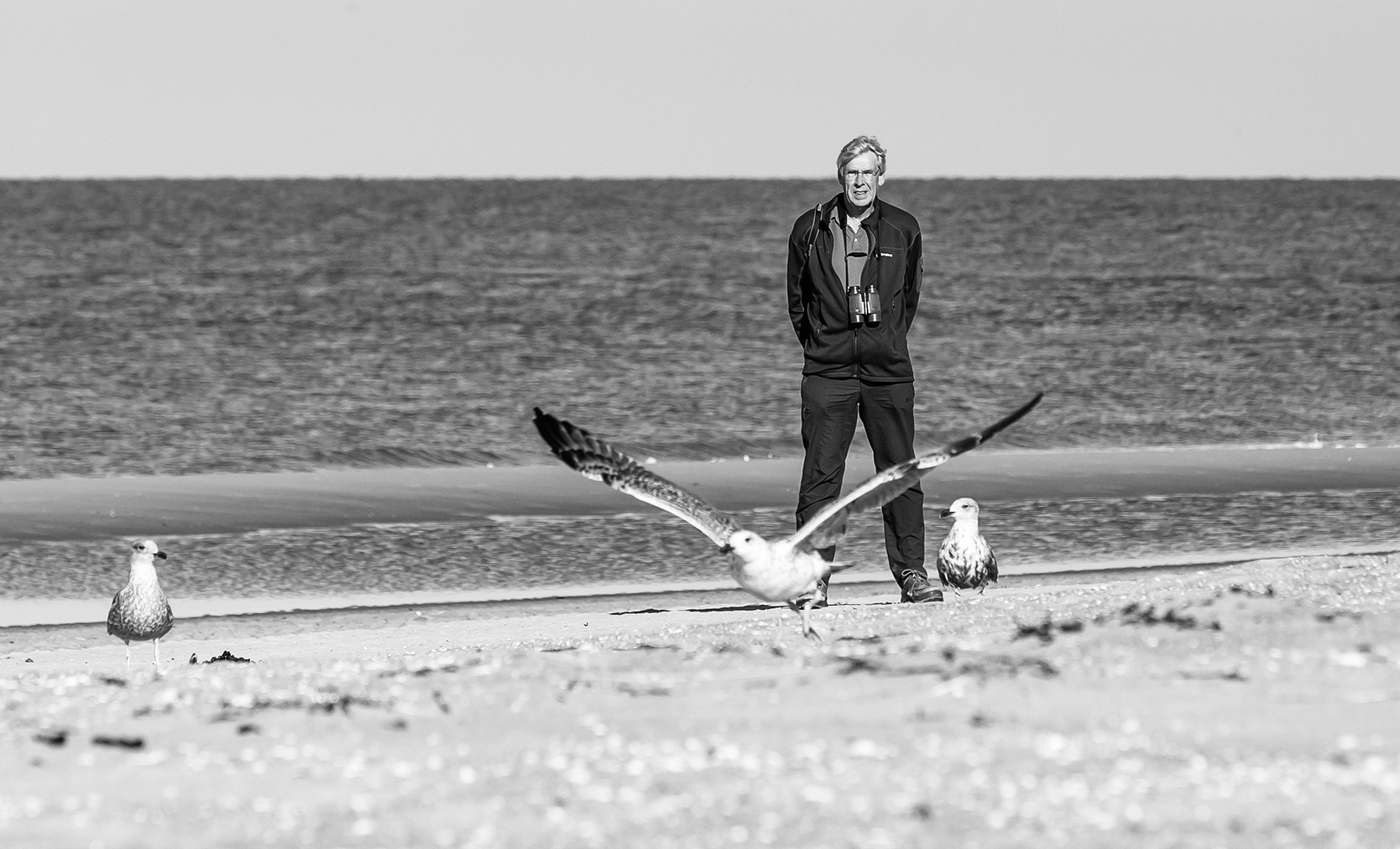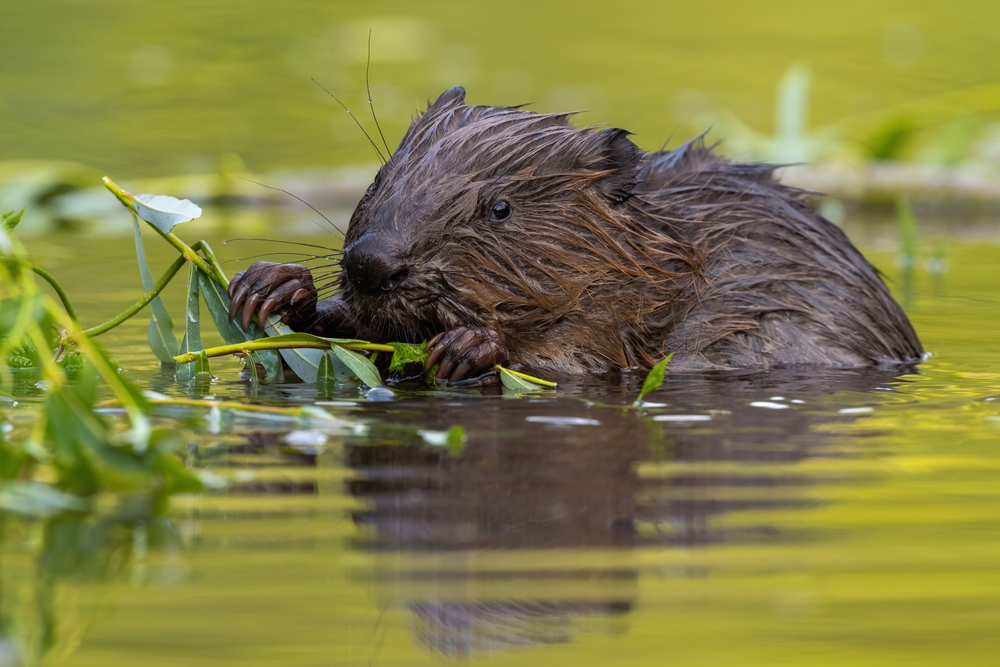The bearded vulture that visited the Netherlands last week ended up dead next to a railway after being hit by a train. Animal ecologist Hugh Jansman examined the bird, assisted by Ralph Buij, a researcher and big fan of birds of prey. ‘It is always impressive. A bearded vulture is a colossal bird.’
It caused major excitement in the Dutch bird-watching scene when news came at the end of April that a bearded vulture had been spotted in the Netherlands. It is the largest species of bird in Europe with a maximum wingspan of about 2.80 metres. This time, the bird that was spotted had been born in the wild, which was a first. The two bearded vultures that had previously been seen in the Netherlands — one didn’t survive after colliding with a wind turbine — had been released into the wild in a reintroduction programme.
The joy didn’t last long. Just over 24 hours after the first observation in the Netherlands, the accelerometer in the GPS transmitter on the bird’s back registered a flatline: no more movement. The location, next to the railway line in the Oostvaardersplassen nature area, did not look promising. Hans Pohlmann, chair of the Vulture Conservation Foundation, went to investigate and as expected, found the vulture dead. ‘Given the cloud of little feathers, she must have been hit by a train and thrown about 20 metres,’ he concluded.
Enormous blow
He brought the bird to Wageningen, where Hugh Jansman, an animal ecologist at Wageningen Environmental Research, performed a post-mortem. He was assisted by his colleague Ralph Buij, who is involved in birds-of-prey projects in the Netherlands and East Africa. Their findings confirm Pohlmann’s assumption that the bird died after a collision with a train. ‘The skull, the wings, the legs: everything was broken. It must have been an enormous blow,’ says Buij.
When such a large bird of prey dies, you need to get to it quickly to get the body somewhere safe for examination
Researcher Ralph Buij
Another discovery was that the bird’s coat of feathers had damage consistent with being hit by lead shot. That news made the press, but Buij can now refute this theory. ‘My colleague Sander Moonen later put the bird through the X-ray machine. It showed just one fragment of lead shot, and in a place in the body that makes it likely the vulture ingested the lead shot with its food.’
Deer leg
During the post-mortem, the researchers made another interesting find. A piece of deer leg that the bird had apparently only just eaten had pierced the vulture’s skin due to the force of the impact. After Jansman was able to carefully wriggle the deer leg out (Omroep Gelderland filmed it), it was still almost entirely intact — the fur and hoof were undamaged — and impressively large: 43 centimetres in length. ‘We were all amazed to find such a large object.’
The ecologist explains that the bearded vulture’s diet mainly consists of bones. ‘Their physical make-up is geared to that. It’s not just the shape of their huge beak or the acidic stomach juices: unlike griffon vultures for example, which mainly sit on or next to carcasses and pick at their food, bearded vultures have claws that can grip onto things. If a bearded vulture comes across something that is too big to eat, such as the ribcage of a chamois, they grip onto it, fly up and drop it from a great height so it smashes.’
Early warning system
Organ samples, for instance taken from the liver and kidneys, will reveal whether this bearded vulture has more surprises in store. ‘Large birds of prey like this are at the top of the food chain,’ explains Buij. ‘Toxins accumulate in their bodies. That makes birds of prey incredibly interesting for ecological research. They are a kind of early warning system. What we find in their bodies says a lot about the ecosystem as a whole: what kinds of chemical contamination are there and how bad is it? If populations of birds of prey start to deteriorate, that means there are problems further down the food chain. Think of the DDT crisis in the 1960s and 70s.’
He thinks it is really something special to have this opportunity to examine such a large bird of prey. ‘It’s really useful as well to have the GPS transmitters telling us where the birds die. Most large birds die anonymously. This is certainly not the first bird of prey to be killed on this stretch of railway, which was already controversial for that very reason in the late 1990s. A rare cinereous vulture has also died here in the past. When such a large bird of prey dies, you need to get to it quickly to get the body somewhere safe for examination.’
Colossal
It is not the first time that a bearded vulture has ended up on a Wageningen dissecting table: in 2021 Jansman and his team examined the wind turbine victim. But it is still an impressive beast, says Buij: ‘A bearded vulture is a colossal bird.’
It is not yet known whether this bird will end up stuffed in a museum, like the wind turbine victim. ‘But Hugh has deliberately been very meticulous in his examination, so it would be possible to stuff the bird for display. And Naturalis has already emailed us. So who knows?’
Mojo, Angèle and Eglazine: ‘The Netherlands is really too full for bearded vultures’
The bearded vulture found dead next to the railway line is known to the Vulture Conservation Foundation as Mojo. It is a female that was born in Mercantour National Park (in the French Alps), an area where bearded vultures are monitored intensively and young bearded vultures are fitted with a GPS tag while still in the nest if possible.
The only bearded vulture to have visited the Netherlands and left again unharmed so far — because the male Angèle died in a collision with a wind turbine in 2021 — is known by the name Eglazine. It is a female that was released near Montpellier (France) in a reintroduction programme. Angèle was first spotted in the Netherlands in 2021. Last year, she spent some time once more in the Netherlands, mainly in the Hoge Veluwe. Buij doubts whether she could visit again safely. ‘The Netherlands is really too full for bearded vultures. They are safer in the mountains where they brood, far away from any railways, wind turbines or high voltage cables.’

 Ralph Buij shows the impressive wingspan. Photo Sander Moonen / Hugh Jansman
Ralph Buij shows the impressive wingspan. Photo Sander Moonen / Hugh Jansman 

